| Name | Miller-Colburn File |
| Lead Time | 0-3 days |
| Competitor | ;PM4554;PM-4554;2349005;23-490-05;261014;26-1014;2610-14; |
| Specialty | Neuro, Ortho & Spine-Rasps & Files |
| Material Finish | Stainless Steel |
| Grade | Premium Operating Room |
| Units of Measurement | Each |
| Manufacturer | Tool Tectra |
| Sterility | Non-Sterile |
| Usage | Reusable |
Miller-Colburn File
double-ended, down-cutting teeth, medium & large ends, octagonal handle, 7-1/4″ (18.4 cm) Miller-Colburn File can be used to soften jagged edges or rough surfaces on bone or other hard surfaces. This file features a slim, octagonal body shaft that doubles as a handle from which two different sizes blade extend on either side. Both ends features down-cutting teeth that allow it to grab hold and uniformly file away at a surface such as the skull or vertebral fragment to protect surrounding tissue from damage in craniotomies or spinal surgeries.
SKU:
TT-SI-9271
Category: Rasps & Files
Description
Reviews (0)
Be the first to review “Miller-Colburn File” Cancel reply
Shipping & Delivery
Related products
Bone Rasp
SKU:
TT-SI-9733
bayonet, 1 side flat & 1 side convex w/ cross-serrations, 9-1/2" (24.0 cm)Bone Rasp is designed to aid in manipulation of bone and other hard tissue surfaces. It can be used to scrape or file away at these surfaces to give them a smoother finish for a variety of reasons. Mainly it is well suited for use in neurosurgical or orthopedic surgeries because these coarse bony areas can cause damage to surrounding tissue if they are not evened out with a file or raspatory. This rasp is a bayonet style and features one flat size and one convex side with cross-serrations that makes it well suited for filing.
Bone File #45
SKU:
TT-SI-6769
double-ended, plain serrations, 6.0 mm & 5.0 mm wide ends, 7" (17.5 cm) Bone File #45 is an instrument crafted for use in neurosurgical orthopedic procedures. It features a hexagonal body that also serves as a grip that makes it easy to handle manually. This file is double ended and features plain serrations as well as two different sized ends: 6.0 mm and 5.0 mm. This instrument can be useful in surgical procedures that require filing or reshaping of bone particularly to prevent damage to surround tissue. Ideally it can be used to protect delicate brain tissue and neurovascular bundles from sharp jagged edges from breaks or from cuts made in surgery.
Bone File #12Ca
SKU:
TT-SI-6376
double-ended, bell pattern, cross serrations, 5.0 mm & 7.0 mm wide ends, 7" (17.5 cm) Bone File #12CA is designed for use in manipulation of bone. This particular file is designed in a bell pattern and is double-ended making it a versatile instrument that can be useful in a vast array of settings. One end is 5.0 mm while the other is 7.0 mm and both features cross serrations. This file can be useful in doing this such as filing down bone when doing grafting procedures or simply to reduce the jaggedness of bone and other hard protuberances that may cause trauma to surrounding soft tissue layers of vasculature.
Polokoff Bone File
SKU:
TT-SI-4144
Polokoff Bone File is a widely used instrument in surgery to aid in mild bone reshaping. Orthopedic neurosurgical procedures such as craniotomies or spinal surgeries such as discectomies require manipulation and handling of very delicate tissue such as nerves or brain tissue itself as well as a vast amount of vasculature. This file can be used to reshape or whittle down bone fragments that are sharp or jagged and could cause injury to any of the above tissue. Additionally this file is available with a short head and fine serrations or a long head with medium serrations.
Bone File #10
SKU:
TT-SI-5389
double-ended, plain serrations, 5.0 mm wide ends, 7" (17.5 cm) Bone File #10 is a general purpose instrument useful in surgical procedures that require manipulation of bone. This file is double ended making it quick and easy to switch to another unused file without having to switch instrumentation. Each end features plain serrations and is 5.0 mm wide. Additionally this instrument features a slightly textured handle surface that reduces slippage making this instrument ideally suited for a variety of precise neurosurgical procedures.
Bone File #64
SKU:
TT-SI-5736
double-ended, plain serrations, 3.0 mm & 4.0 mm wide, 7" (17.5 cm) Bone File #64 is a double ended instrument that can be used in a variety of surgical procedures. This file features plain serrations and can be used to smooth out sharp edges on bone during surgery. In surgeries where such delicate tissue is involved such as nerves, vessels or even brain tissue it is imperative to keep sharp surfaces from causing tear injuries. Additionally this instrument is comprised of premium German operating-room grade stainless steel.
Bone File – Single-Ended
SKU:
TT-SI-2538
single-ended, 2-sided convex & flat blade, 23.0 mm width tapers to 6.0 mm, 11" (28.0 cm) Bone File is a ideally suited for many different surgical procedures. It is specifically designed to be used to file away at bone fragments that are caused by breaks or cuts or on coarse hard tissues in different parts of the body. They can be especially useful in neurosurgical and orthopedic procedures that can involve maneuvering and exploring around many different bony areas such as the skull, long bones and vertebral column. Additionally this file is single sided with a convex and flat blade and a 23.0 mm width that tapers to 6.0 mm.
Bone File #12
SKU:
TT-SI-7944
double-ended, plain serrations, 7.0 mm & 5.0 mm wide ends, 7" (17.5 cm) Bone File #12 can be used in a variety of surgical interventions in neurosurgery or orthopedic surgery. This instrument is double ended with each end featuring plain serrations. It is ideally suited for use in filing bones such as reducing a sharp or jagged bone edge to prevent damage to surround tissue or delicate neuro-vascular bundles. Additionally each even here is a different width: 7.0 mm and 5.0 mm making it versatile enough to be used in a number of different surgical scenarios and can satisfy any surgeon preference.


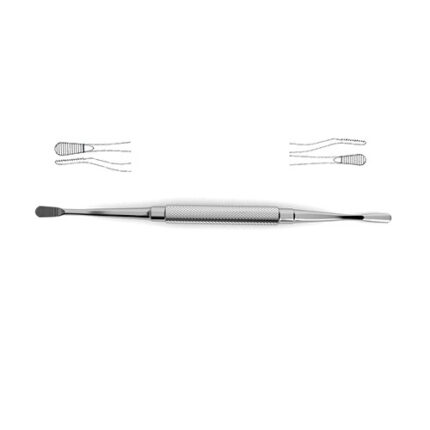


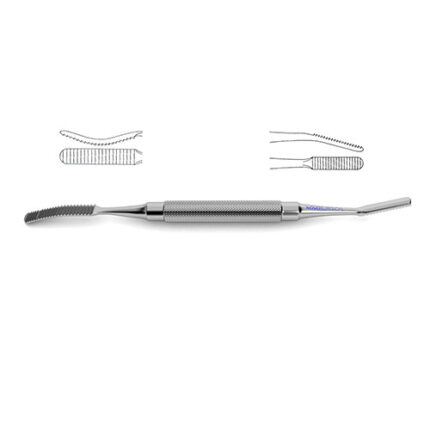
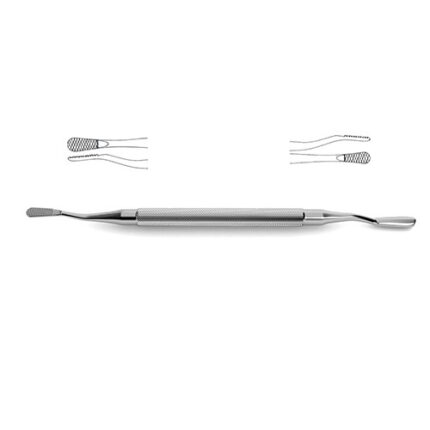

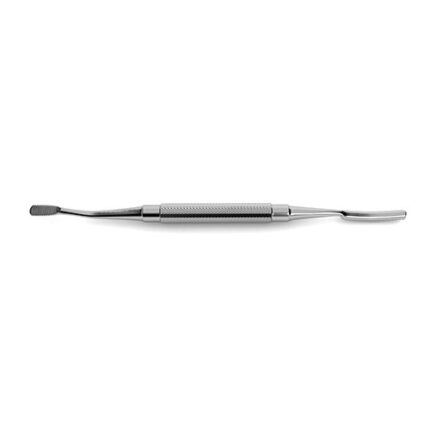
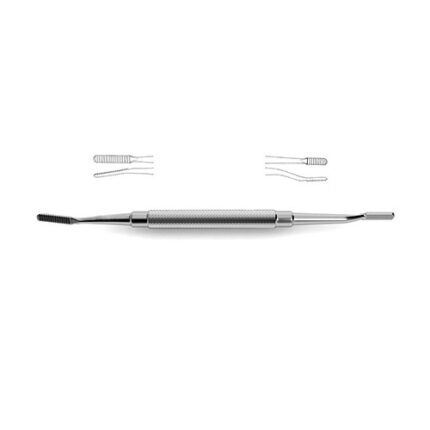


Reviews
There are no reviews yet.